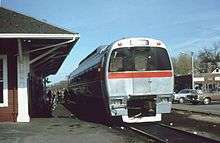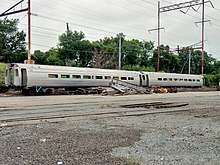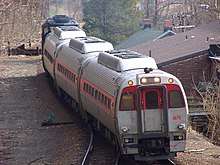Budd SPV-2000
| SPV-2000 | |
|---|---|
|
SPV-2000 No. 293, formerly of Metro-North Railroad, preserved at the Connecticut Eastern Railroad Museum | |
| Manufacturer | Budd Company |
| Constructed | 1978–1981 |
| Number built | 31 (plus 14 unassembled shells) |
| Capacity | 86–109 |
| Operator(s) |
Federal Railroad Administration ONCF CDOT/Amtrak MTA/Metro-North Caltrain (used as inspection cars) |
| Specifications | |
| Car length | 85 feet 4 inches (26.01 m) |
| Width | 10 feet 6 inches (3.20 m) |
| Height | 14 feet 6 inches (4.42 m) |
| Maximum speed | 80 to 120 miles per hour (130 to 190 km/h) |
| Weight | 127,000 pounds (58,000 kg) |
| Track gauge | 4 ft 8 1⁄2 in (1,435 mm) standard gauge |
| Notes | |
| [1] | |
The Budd SPV-2000 is a self-propelled diesel multiple unit railcar built by the Budd Company between 1978 and 1981 for use on North American commuter railroads. The design was a successor to Budd's popular Rail Diesel Car (RDC) but based on the body of the Amfleet passenger car. It did not prove a success: Budd built 31 cars and they proved mechanically unreliable.
Design

Budd announced the design in 1976. At the time it contemplated multiple unit operation of up to six cars with a top speed of 120 miles per hour (190 km/h). Power would be provided by 360 horsepower (270 kW) General Motors diesel engines. Popular Science depicted a tapered cab similar to the power car of the Advanced Passenger Train; the SPV-2000 would enter service with a more traditional blunt-end operator's cab.[2] Budd said that SPV stood for "Special Purpose Vehicle" (Self-Propelled Vehicle became common), and emphasized the design's suitability for both intercity and commuter rail service.[3]
The body shell of the SPV-2000 was very similar to the Amfleet passenger coach, which in turn was based on the Metroliner electric multiple unit. The SPV-2000 featured operator cabs at both ends and (in the standard configuration) 86 seats in 22 rows. There was an accessible toilet at one end and a small space to store luggage at the other.[1] Metropolitan Transportation Authority (MTA) cars could seat 109.[4]
Operators

Budd unveiled the first SPV-2000 in Philadelphia on February 9, 1978, and then sent it on a demonstration tour around the United States.[5] Budd eventually sold SPV-2000s to four customers: the Federal Railroad Administration (FRA), ONCF (Morocco state railways), the Connecticut Department of Transportation (CDOT), and the Metropolitan Transportation Authority (MTA).[1] In 1978 Los Angeles County Supervisor Baxter Ward proposed using SPV-2000s on the former Pacific Electric line to Long Beach, California, but nothing came of this proposal.[6] The SPV-2000s were considered for a resumption of Cape Cod rail service via Braintree, Massachusetts and an SPV-2000 made a demonstration run in August 1979, but nothing came of this either.[7] Beyond the 30 cars it sold, Budd constructed the demonstrator and 14 incomplete shells.[8] In the early 1990s the North American Carriages Company proposed to complete some of these shells as standard passenger cars for use in a new service between San Antonio, Texas and Monterrey, Nuevo León, to be called the Royal Eagle, but nothing came of the proposal.[9]
FRA
The Federal Railroad Administration purchased a single SPV-2000 in 1981 and converted it into a track geometry car which it designated T-10. The T-10 remained in service with the FRA until 2000 when it was replaced by newer equipment.[10] It was then sold to Caltrain.[11]
ONCF
Budd sold six SPV-2000s to ONCF (the Moroccan state railways) for use on King Hassan II's royal train.[1][3] Under King Mohammed VI, Hassan II's successor, the train has fallen into disuse.[12]
ConnDOT

The Connecticut Department of Transportation purchased 13 SPV-2000s at roughly $1 million apiece in 1980; 12 for use on the New Haven–Springfield Line and one for commuter service on the Danbury Branch.[13] The New Haven–Springfield Line cars were leased to Amtrak (numbered 988–999) and painted in Amtrak's Phase III livery. The cars were designed to be interoperable with Amfleet cars; for a brief period, Springfield shuttles were coupled to the rear of Boston trains at New Haven to provide through service to Washington, D.C.[14]
The cars proved mechanically unreliable and were often pulled by locomotives, leading to the derisive sobriquet "Seldom Powered Vehicles". Amtrak withdrew them on January 12, 1986 and placed conventional locomotive-hauled Amfleet trains on the route. The cars saw some use on the Metro-North Railroad; most were stored in New Haven. In 1994, the remaining 11 were de-powered and converted to coaches for use on Shore Line East commuter service.[8][15] Dubbed "Constitution Liners", they were the primary coaches for Shore Line East until replaced by Mafersa coaches in 2004.[16]
MTA
The MTA purchased ten SPV-2000s for use on its Hudson Line between Croton–Harmon and Poughkeepsie. The order cost $12 million. The SPV-2000s made their first runs on October 17, 1981. This run was coordinated with the re-opening of the New Hamburg station.[4] Problems with the SPV-2000s developed quickly, and a 1982 New York magazine article characterized the cars as "defective".[17] The MTA SPV-2000s are all out of service; one is preserved at the Connecticut Eastern Railroad Museum in Willimantic, Connecticut.[18]
See also
Notes
- 1 2 3 4 TransitAmerica (1985). "Brochure". p. 20. Retrieved 2014-05-26.
- ↑ "What's New". Popular Science: 96. November 1976.
- 1 2 "Budd Company Survives Slumping Railroad Passenger Car Industry". Colorado Springs Gazette-Telegraph. December 11, 1977.
- 1 2 "William E. Sauro New Cars for Hudson Line Commuters". The New York Times. October 18, 1981.
- ↑ Crouse 1990, p. 141
- ↑ "Another Area Transit Proposal for California". Pacific News. Vol. 18 no. 6. June 1978. p. 4.
- ↑ Eldredge 2003, p. 109
- 1 2 Crouse 1990, p. 146
- ↑ TxDOT 1992, p. 11
- ↑ Solomon 2001, pp. 35–36
- ↑ Solomon 2012, p. 283
- ↑ Boudarham, Mohammed (April 10, 2009). "Nostalgie. La fabuleuse histoire du train royal". TelQuel (in French).
- ↑ Madden, Richard L. (20 October 1982). "SENATOR BAKER APPEARS IN HARTFORD FOR WEICKER AND STATE REPUBLICANS". The New York Times.
- ↑ Solomon, Brian (2004). Amtrak. Saint Paul, Minnesota: MBI. p. 154. ISBN 978-0-7603-1765-5.
- ↑ Simon & Warner 2011, p. 89
- ↑ "Shore Line East". Trains. July 5, 2006. Retrieved May 26, 2014.
- ↑ Klein, Joe (March 8, 1982). "The Woman Who Would Be Mayor". New York: 29.
- ↑ Connecticut Eastern Railroad Museum. "SPV 2000". Retrieved May 26, 2014.
References
- Crouse, Chuck (1990). Budd Car, the RDC Story. Mineola, NY: Weekend Chief Publishing. ISBN 0-9612814-2-1.
- Eldredge, Andrew T. (2003). Railroads of Cape Cod and the Islands. Images of Rail. Charleston, SC: Arcadia Publishing. ISBN 0738511579. OCLC 53277772.
- Simon, Elbert; Warner, David C. (2011). Amtrak by the numbers: a comprehensive passenger car and motive power roster, 1971-2011. Kansas City, Missouri: White River Productions. ISBN 978-1-932804-12-6.
- Solomon, Brian (2012). North American Locomotives: A Railroad-by-Railroad Photohistory. Minneapolis, MN: Voyageur Press. ISBN 9780760343708. OCLC 781679692.
- Solomon, Brian (2001). Railway maintenance equipment. Osceola, WI: MBI. ISBN 0760309752. OCLC 46976669.
- Texas Department of Transportation (1992). Designation Of The San Antonio - Laredo - Monterrey, Mexico High Speed Rail Corridor (PDF).
External links
| Wikimedia Commons has media related to Budd SPV-2000 cars. |